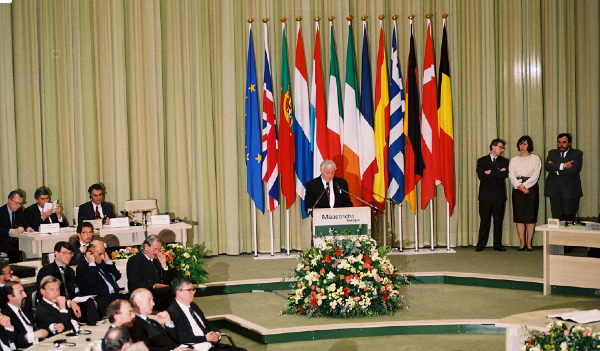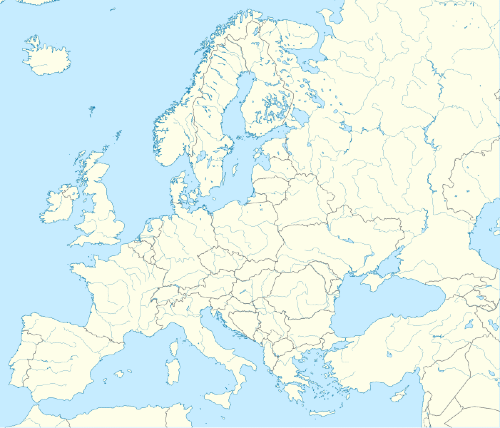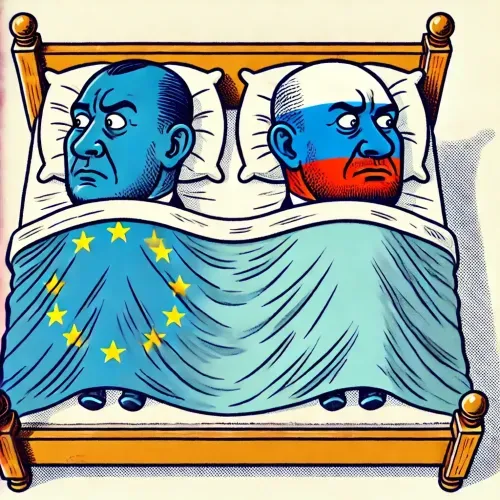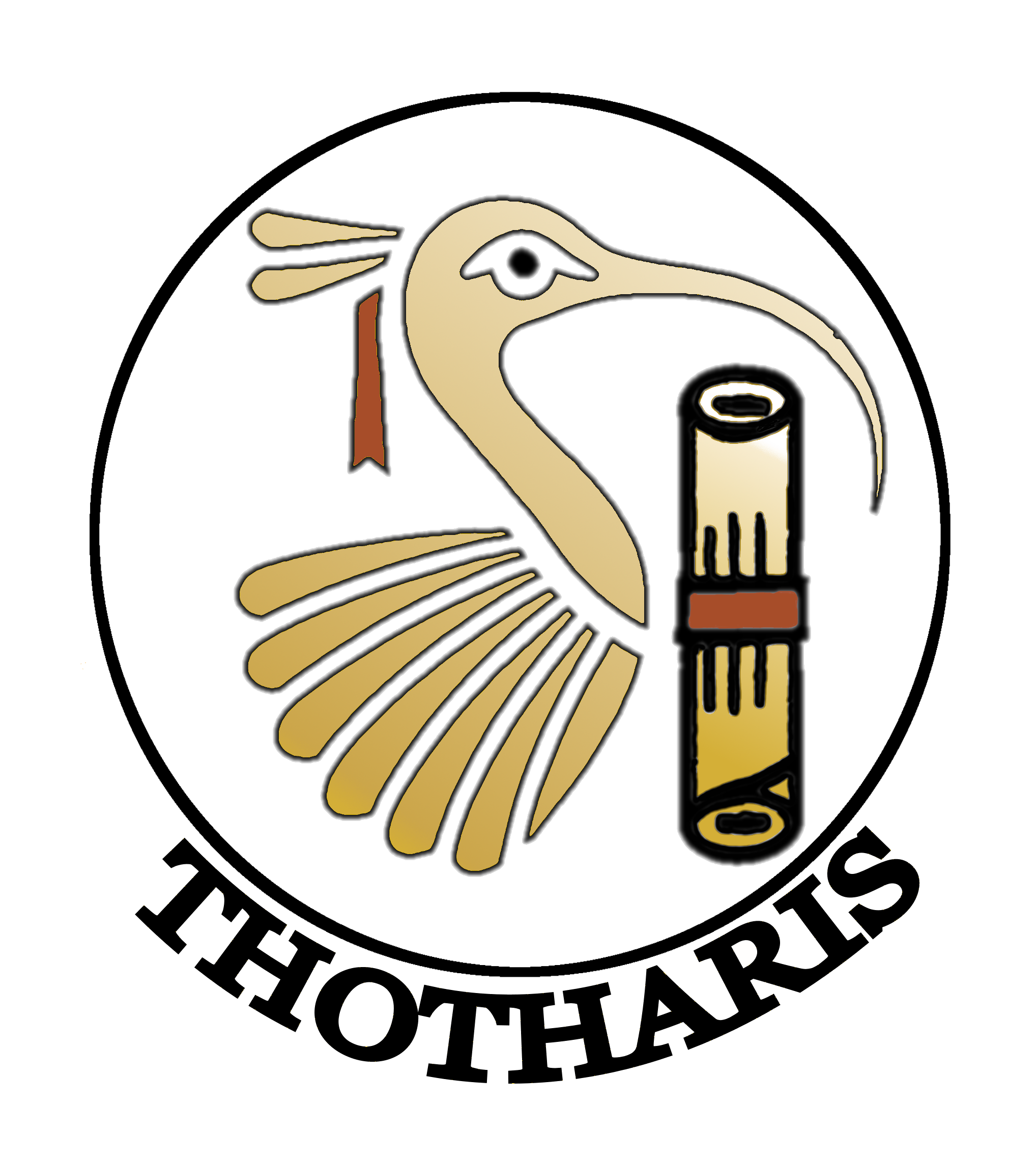Europe and NATO: Shield or Shackle?

Share
As global tensions rise and alliances are tested, Europe finds itself at a crucial juncture. Bound to NATO’s security framework yet increasingly aware of its own strategic interests, the European Union must confront the question: does its alignment with NATO serve as a safeguard or a constraint? With Russia challenging Europe’s stability and the U.S. shaping NATO’s priorities, Europe’s reliance on the alliance may be both a shield and a shackle. Through this piece I examine the paths available to the EU at this inflection point of continental security, as well as its role on the global stage—should Europe stay the course with NATO or to forge a more autonomous defense identity?
From Shield to Strategy: NATO’s Rise as Europe’s Protector

With WWII over, Europe lay in ruins, vulnerable to a new threat from the east. The USSR, having helped defeat Nazi Germany, now sought dominance across the continent, installing communist regimes and drawing a hard line through Europe—what Churchill famously termed the “Iron Curtain.” Exhausted but wary of falling under Soviet influence, a group of Western European nations took action, forming the Western Union Defense Organization (WUDO) in 1948. But without U.S. support, WUDO was not enough of a deterrent to counter the USSR's growing power.
Realizing they could not go it alone, these nations sought American partnership. By 1949, the North Atlantic Treaty established NATO, a collective defense pact that quickly became Europe’s shield. Bolstered by U.S. might, NATO’s Article 5 promised a united response to any attack on its members, creating a formidable deterrent to Soviet ambitions.
With the Soviet Union’s collapse in 1991, NATO evolved, broadening its scope, outlining its priorities in its 1991 Strategic concept to include a broader spectrum of threats, including terrorism, sabotage, and maintaining stability and peace in the countries on the southern periphery of Europe.
Shortly after that, in 1999, NATO’ renewed strategic concept tied the security of North America permanently to the security of Europe, setting itself up as the primary Euro-Atlantic body empowered to address an evolving strategic environment. Interestingly, It also stated its support for the development of a European Security and Defense Identity.
NATO went through various stages throughout the early 2000s. It adopted a more global and agile outlook, while retaining collective defense as its core purpose throughout. In 2014, Russia’s annexation of Crimea renewed NATO’s purpose, solidifying its role as the preliminary continental counterweight to a growing Russian threat. Eight years later, in 2022, NATO consolidated its role as the primary shield for Europe as Russia renewed its attack on Ukraine.
In 2022, shortly after the outbreak of the Russia- Ukraine war, NATO’s strategic concept described Russia as the most significant and direct threat to Allies’ security, and to peace and stability in the Euro Atlantic area, laying the blame for continental instability squarely on the shoulders of Russia.
From its inception in 1949, to its regained prominence in 2022, NATO has served as the European shield against threats and security challenges for seven decades and has become synonymous with European security.
Today, NATO’s influence is unmatched in Europe, but as the alliance continues to expand its mandate, has Europe sacrificed its own security autonomy in the process?
A Continental Identity: Europe’s Security Choices

Europe in 2024 is far from the war-ravaged continent of 1949. The EU has transformed the continent into a prosperous economic powerhouse, with the 27-member bloc now representing one of the world’s largest economies, a collective GDP of over $26 trillion, and some of the most advanced military industries globally.
What began as the European Coal and Steel Community is now a bloc with shared borders, a common currency, and a robust defense framework. The 2004 creation of the European Defence Agency (EDA) and the establishment of the Common Security and Defence Policy (CSDP) reflect Europe’s strides toward a unified security front. This shift is not just about defense—it’s about setting security priorities that align with the EU’s unique needs, that are distinct from NATO’s mandate.
Despite significant overlap—23 out of 27 EU countries are NATO members—the EU and NATO are increasingly distinct in their perspectives and priorities. As geopolitical realities shift, what may serve NATO does not always serve Europe’s long-term strategic goals.
With the shifts in the geopolitical landscape over the past decades, and more acutely over the past five years, an important question arises: is Europe’s continued investment in NATO, in its current format, a benefit or a burden? While NATO provides a unified front against threats like Russia, it’s worth asking if NATO’s presence is a shield or a lightning rod for Europe. With the EDA and CSDP already in place, could they not provide enough of a foundation for Europe’s collective defense? Or at least play a more prominent role in setting European security priorities?
As Europe continues to evolve its security capabilities, exploring its options could lead to a tailored defense strategy that aligns more closely with its unique needs, one less reliant on the perspectives of actors whose global priorities may diverge from its own.
Tunnel Vision: NATO’s One-Dimensional Approach

NATO, incepted as a military alliance, has by necessity adopted a binary worldview. This narrow perspective, built on a mission of defense, leads NATO to approach global security issues in adversarial terms.
Over decades, NATO has evolved its own organizational identity and purpose, becoming an entity with a culture distinct from its member states. Like other longstanding organizations, NATO’s drive to perpetuate itself can lead to problem inflation: every new threat justifies its existence.
In a rapidly evolving geopolitical landscape, with increasingly complex security challenges this is not necessarily a drawback; adapting to changing circumstances is the hallmark of a successful organization. However, the trouble arises when this organization’s perspective replaces the broader perspective of its member states.
In what increasingly seems like the tail wagging the dog, NATO as an organization seems to have disproportionate influence on the European perspective on global affairs, eclipsing the broader perspectives that EU members could obtain through substituting this lens with one more inclusive of the myriad of tools at their disposal.
To this point, NATO is already framing future threats. In his final report to the member states, the former Secretary General of NATO identified China as a country that does not share NATO’s values, and is “challenging our interests”, defining engagement with China in terms of ‘risk management’ and ‘enduring competition.’ In doing so, he set the stage for the next adversary that NATO will ‘have to’ face. Interestingly, this statement is diametrically opposed to the position stated by the French president Macron in 2023 where he emphasized the necessity of avoiding getting dragged into a confrontation between the US and China.
As a result of its identity and the raison d’etre, NATO -the organization not the alliance between members- requires an adversary to justify its existence. The EU however does not. Europe as a continent does not. If by some miracle sustainable peace were achieved tomorrow, Europe and the EU would not only endure, but would thrive. NATO on the other hand would find itself out of a job.
Therin lies one of the paramount points of divergence between NATO and Europe, and one of the points that should inspire Europe to take another look at who is leading the relationship; a relationship led by NATO would create a state of perpetual conflict justified by the tunnel visioned lens through which NATO as an organization perceives the world. NATO’s approach reflects its self-sustaining mission but doesn’t necessarily align with Europe’s best interests.
The result? NATO’s worldview can override the broader strategic outlook of its member states. In promoting its own agenda, NATO risks fostering a security climate in Europe that magnifies threats, limiting Europe’s ability to cultivate a nuanced approach to global challenges.
For Europe, this narrow vision could lead to perpetuating conflicts that might otherwise be resolved. NATO’s “hammer” view not only shapes its approach to Russia but may preclude more balanced diplomacy. Ultimately, Europe’s interests could be better served by a strategic lens that includes but is not defined solely by NATO’s binary worldview.
Fragmented Voices: How NATO’s Structure Weakens Europe’s Unity

From NATO’s organizational worldview we move onto the internal dynamics that shape decision making within the alliance.
NATO’s decision-making process relies on consensus—a structure that, in theory, gives each member an equal voice. However, in practice, this mechanism often tilts power in favor of NATO’s most influential member: the United States. While consensus appears to safeguard individual voices, it can dilute Europe’s collective influence.
Within this context, the US can wield its substantial diplomatic weight to sway individual member states to its point of view, skirting engagement with Europe as a cohesive bloc where it may face more resistance. This shifts the power balance within the alliance away from Europe and its EU members, effectively disavowing them of their collective bargaining power; in NATO’s structure, Europe’s unified voice remains fragmented, often deferring to the alliance’s strongest member.
If we take a step back to the eve of the Russia Ukraine war in early 2022, we find that both France and Germany were initially reticent to escalate with Russia. They advocated for de-escalation, but the U.S.’s assertive diplomatic campaign secured support for a hard-line stance. Even Europe’s largest powers found it challenging to counter the U.S. push within the NATO framework, underscoring the comparatively lower influence of smaller European members. This indicates that European influence will remain limited within NATO; the US is capable of securing support for its objectives through intensive diplomatic campaigns throughout the continent.
This is an important consideration because the US scope of interests does not always align with that of the EU and its members, and with a fragmented Europe in NATO, it remains susceptible to decisions that reflect US rather than European strategies in the region and globally.
Europe for example could have explored mechanisms to integrate and absorb Russia as an extension of Europe (if it had allowed itself to look outside the narrow scope of NATO), creating a cohesive force and power pole that would rival US global hegemony and infuse the continent with much broader independence of decision and action. The US meanwhile would be opposed to the materialization of this partnership; a consolidated EU Russian pole would severely limit US global influence.
Strange Bedfellows

For Europe and Russia, an alignment might seem counterintuitive, given historical tensions and current hostilities. Yet, in realpolitik terms, a partnership could unlock significant strategic benefits for both sides. Russia’s economic and strategic interests often align more closely with Europe than with its current reliance on China—a partnership that leaves it at a disadvantage due to China’s superior economic and demographic power, not to mention its expanding military might. Furthermore, with its current antagonism toward Europe, Russia is also perpetually vulnerable on its western flank and continues to expend considerable resources on securing it.
Europe is in a similarly disadvantageous position in its partnership with the US. It is outmatched in influence, economic and military power, and the U.S. wields substantial control over NATO’s priorities, often leaving Europe’s own strategic goals unfulfilled. As we saw in the lead up to the Russia Ukraine war where the US outlook won the day.
Both Russia and Europe, if they were to give the question due consideration, may find it in their interests to set aside their differences and chart a new course for the continent; with Russia, Europe could establish a more equitable partnership—one that strengthens continental security without relying on the U.S. for support.
Europe’s partnership with Russia could also reduce economic vulnerability. A cooperative relationship would limit Europe’s dependence on distant U.S. policies and provide greater access to Russian energy resources, counterbalancing reliance on other global actors. While fraught with challenges, a reimagined Europe-Russia partnership might serve as a balancing force, allowing Europe greater latitude in global affairs.
Of course, such an alliance would require both sides to set aside longstanding animosities and overcome significant trust issues. Yet, if Europe seeks greater autonomy and influence, this partnership presents an avenue worth considering—one that could elevate Europe from its current role within NATO to a self-determined force on the global stage.
As it stands today, Europe could find itself bearing the brunt of NATO decisions, rather than benefiting from them. It could find itself caught in a quagmire not of its own creation, but rather caught between the behemothic powers of the US on the one side and the Sino-Russian alliance on the other, as President Macron alluded to.
Redesigning Its Approach to NATO?
Europe had an opportunity in late 2021 to assert a more independent security approach amidst rising continental tensions. With existing structures like the European Defence Agency (EDA) and the Common Security and Defence Policy (CSDP), the EU could have adopted a security outlook distinct from NATO’s, prioritizing its own regional stability and interests.
Those European agencies offer an alternative path to the one led by NATO, one that provides the EU the freedom to chart its own course and shape its own security strategy without defaulting to NATO’s overarching worldview.
Even within NATO, EU nations still have an opportunity to, for example, consolidate their positions on continental issues rather than approach the matter as individual members. The collective bargaining power of the EU could be more effectively leveraged within the framework of NATO to temper its actions and perspectives.
The window is closing however, and with every passing day of escalating tension between NATO and Russia, Europe’s chances of reshaping its approach are dwindling. The EU still has a window of opportunity to step back from NATO’s binary perspective on security, fostering a more balanced stance that does not hinge solely on the security perspective, but leverages the extensive set of tools at the EU’s -and Europe’s- disposal to effectuate real change and stability on the continent. But this window may soon close, leaving Europe bound by a strategy that may no longer serve its best interests.
While this shift holds potential, it is fraught with obstacles, not least among them that it does not align with US interests on the regional or global levels. Furthermore, the EU has become relatively disjointed and lacking in cohesion and vision. Germany, since the election of Chancellor Olaf Scholz and his government in December 2021 has fared less than ideally on the international stage, seemingly regressing in strategic vision and outlook both on European and global affairs.
France, seemingly the primary European state attempting to localize decision making for European future, has not had much success. President Macron has indicated on various occasions that he supports a Eurocentric approach to security and defense, and the development of an independent European outlook that does not rely on or automatically follow US led objectives.
Conclusion: A Crossroads for European Sovereignty

Europe stands at a pivotal moment. NATO has long been the bedrock of its security, but as global dynamics shift, so too must Europe’s approach to its own defense. While NATO’s steadfast alliance offers protection, it also binds Europe to decisions that may not serve its long-term interests. The EU’s existing structures provide an alternative—a chance to define a defense strategy rooted in European priorities, free from the influence of external powers be they allies or rivals.
Yet, this opportunity is fleeting. With every NATO engagement, Europe’s ability to step back diminishes. If it is to avoid becoming a perpetual participant in conflicts driven by outside agendas, Europe must act decisively, leveraging its own resources to foster stability and independence.
The question remains: will Europe seize this moment to forge its own path, or continue in NATO’s shadow, bound to choices beyond its control? The answer will shape not only Europe’s future security but its place on the global stage.
